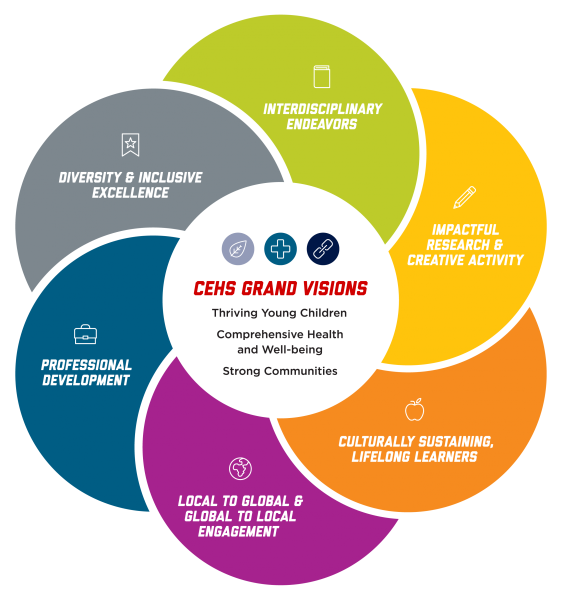A LIVING STRATEGIC PLAN 2022 - Collective Grand visions:
Growing a people’s College

The College of Education and Human Sciences is dedicated to enhancing the lives of individuals, families, schools and communities and strengthening the relationships among them.
Values
In pursuing our mission, we are guided by shared values that inform every aspect of our work in local, national and global contexts.
- Excellence in all aspects of the life of the College;
- Innovation, creativity, and curiosity as we address the complex issues facing individuals, families, schools, and communities;
- Respect for diverse people, ideas, voices, and perspectives;
- Multidisciplinary approaches to scholarship that integrate teaching and learning, research, scholarship, and creative activity, outreach, and service;
- Working together to positively impact the lives of individuals, families, schools, and communities;
- Partnering with people in the community to support the mission and vision of the College of Education and Human Sciences;
- Emphasizing the creation of new knowledge and its application to human and community needs thereby combining the strengths of a research and a land-grant university
Preface
In 2017, the University of Nebraska Lincoln embarked on envisioning its future resulting in the N150 report emphasizing every person and every interaction, research and creativity that transforms lives, students co-creating their experience and engagement that builds communities. The N150 vision was followed by campus-wide strategic planning that created the N2025 plan, which reinforced every person and every interaction, emphasized interdisciplinary work to meet grand challenges, and underscored experiential learning.
The strategic plan for the College of Education and Human Sciences aligns with the N2025 plan in our mission to enhance lives and strengthen relationship, our grand visions that have high potential for collective teamwork and impact, and experiential learning as the hallmark of our programming. Collective Grand Visions: Growing a People’s College is critical for our growth and development as a community. It serves as a guiding document for interdepartmental, interdisciplinary, collective work to positively impact every inhabitant of our state, our nation and the world. While the aims are well aligned with the N2025, many of the strategies and outcomes are people focused and units may choose the elements that are most relevant for their goals and aspirations. No one is expected to do everything, but every person and every unit has a distinct and important role to achieve the plan.
Programming in Education and Human Sciences has a 100+ year history at the University of Nebraska. The College of Education and Human Sciences (the College) was formed in 2003 when the College of Human Resources and Family Sciences joined with Teachers College. The formation of the College of Education and Human Sciences occurred through a thoughtful, strategic, and collaborative process to integrate seven departments into an effective and efficient college that is well positioned for 21st century grand challenges. That collective work created a college that focuses on people, values the unique contributions of every discipline, catalyzes the strengths of each member of the college, and works together toward a shared future. Our union was highly successful; we are a true community of scholars.
Mission
After 18 years of working together to positively impact people’s lives, our mission to enhance the lives of individuals, families, schools and communities and strengthen the relationships among them continues to be critically important as we navigate a global pandemic and are moving forward toward a post-pandemic world. At the same time, Nebraska, and the nation at large, continue to grapple with the legacy of racism and other forms of bias that impact the life chances and educational opportunities for many of our neighbors and the communities we serve. While we plan for post-pandemic realities, we must simultaneously commit ourselves to ensuring equal opportunity for access to all that the College has to offer.
Grand Visions
The College values working together to positively impact the human condition and solve challenges critical to Nebraska and the world. Our work, like many of our fellow Nebraskans, is outward-facing and engaged in national and international endeavors. For this reason, we focus not only on statewide initiatives, but also national and global research and engagement.* Bringing our interdisciplinary* expertise together creates collective genius.
Together, we will advance our collective genius across three grand visions: Thriving Young Children, Comprehensive Health and Well-being, and Strong Communities. These grand visions arose from areas where the College has had, and continues to have, significant leadership on campus and in the state including paving the way for other groups to have impact. The College was at the table in making these areas important foci for the state, the university system and the campus. They were also reinforced through conversations with College alumni and stakeholders as well as discussions with College faculty, staff and students.
The College’s grand visions represent areas where every unit can contribute and are well aligned with NU system investments, UNL Grand Challenges, and Blueprint Nebraska aspirations. Each grand vision lays a foundation for why the College exists and what we, as a people’s college in a land-grant institution, aspire to accomplish collectively

 Thriving Young Children
Thriving Young Children
Young children are the world's future. In Nebraska, from the work of the Early Childhood Workforce Commission,1 Blueprint Nebraska,2 Voices for Children,3 and First Five Nebraska,4 we know that:
- Disparities across socioeconomic, racial, ethnic and other identities affects access to childcare, readiness for kindergarten and educational attainment by grade 3. For example, 37% of Nebraska’s children, age 0 to 5, are at risk of failing in school. In 2019, 63% of Nebraska’s fourth graders were not proficient in reading.
- Adverse childhood experiences (ACE) can have negative and lasting effects on health and well-being of young children. The experience of ACEs extends beyond the young child and can cause consequences for the family and community.
- Families, caregivers and communities are important contributors to the development, health, well-being and growth of young children. In Nebraska, 75% of children under the age of 6 live in homes where all adults in their family work outside the home.
- A highly qualified, diverse early childhood workforce is the cornerstone of high-quality early care and education. In Nebraska, with a shortage of 58,000 workers, the need for high-quality early care and education is critical.
- A family’s ability to access early care and education varies based on where they live. For example, in Nebraska, 11 counties have no licensed childcare facilities. Furthermore, 84% of Nebraska counties that have childcare facilities lack sufficient childcare slots to meet the needs of families living in the county.
- Investment in early care and education plays an important role in the economic vitality of communities. A community’s collective ability to attract business investment is dependent upon leadership, the size and qualifications of the labor supply available, and labor supply is dependent in part upon access to affordable early care and education opportunities for the children of potential employees.
- Investment in early care and education yields a significant return on that investment. For example, one dollar spent on high-quality early care and education yields an average return of $4 over time. In circumstances where children are extremely vulnerable, the return can be as high as $13.5
- The educational pathway* begins at birth and extends through post-secondary opportunities made accessible by inclusive, skillful and collaborative leaders.
- Employing policies, systems and environmental (PSE) approaches through evidence-based Extension programs and interventions can improve young children’s health behaviors and health outcomes.
The College of Education and Human Sciences envisions that every young child will be ready to thrive by the time they reach kindergarten. And, by age 8, every young child will be on a positive trajectory to achieve their maximum potential. CEHS commits to accompanying children as they develop into youth, positioning them to be successful in their future careers and to contribute to their communities in meaningful and constructive ways.
 Comprehensive Health and Well-being
Comprehensive Health and Well-being
Advancing the physical, mental, emotional, psychosocial and community health and well-being of diverse populations generates health and well-being for all. According to a variety of sources:
- Health inequities disproportionately affect individuals and families living in poverty, minoritized* communities, and persons with disabilities.
- Promoting and building resilience in families across diverse communities through family and community-level engagement will aid in resolving disparities in health outcomes that exist across the lifespan.
- In Nebraska, 34.1% of adults, 11.5% of youth (10-18 years of age) and 15.2% of young children (2-4 year olds) are obese.6 Obese individuals may experience lower quality of life and may develop serious obesity related diseases.
- Neighborhood and family context may affect physical access to affordable and nutritious food, creating ‘food deserts’ in communities.7 This puts residents at risk for food insecurity and food insecurity places adults and children at increased risk for a variety of negative health outcomes and health disparities.8 12.8% of Nebraskans report food insecurity, where they lacked the money to buy food they needed.
- Disability can be congenital or acquired and can have lasting impacts on individuals, families, and communities. At least 20% of adults (>18 years of age) in the United States (more than 53 million people) report some type of disability.9 Prevalence of disability in Nebraska has been shown to be 0.3% among children less than 4 years of age, 5.2% for ages 5 to 15 years, 7.3% for ages 16 to 20 years, 26.2% for ages 65-74 and 45.2% for people over age 75.10
- The World Health Organization emphasizes that there is no physical health without mental health. Challenges with mental health affect all ages. One in five adults in the United States experience mental health difficulties in a given year. One in 25 adults experience serious mental health concerns. One in six youth (ages 6-17) experience a mental disorder each year. By 2030, depression may be the leading cause of disability worldwide.11
- There are critical health workforce gaps in Nebraska, the U.S. and globally.12 Many communities, particularly in rural* areas, lack access to a wide range of health professionals including counselors, psychologists, community health experts, dietitians, speech language pathologists and audiologists.
- Integrated systems that leverage expertise in families, communities and preschool through post secondary (P-20) educational environments bolster access to resources/supports and better promote health and well-being.
- Long-term human and community health is also inextricable from environmental health. The consumer-environment relationship demands innovative approaches to sustainability in terms of design, production, and consumer and industry practices.
The College of Education and Human Sciences envisions that every person has access to research based, culturally relevant, leading edge health and wellness resources, expertise and services that are well integrated into the community, highly acceptable and used. CEHS aspires to a comprehensive approach to health and well-being that accounts for the relationships between social, mental, and physical health and how health and well-being relate to the material world and the environment.
 Strong Communities
Strong Communities
Capitalizing on Nebraska’s rural and urban assets fosters community, equity,* and economic prosperity. CEHS works to strengthen communities through particular contexts such as teacher education, families, schools, community colleges, commerce and healthcare. Information from a variety of sources tells us that:
- In 2020, the five largest ethnic groups in Nebraska were White (Non-Hispanic)(75.7%), White (Hispanic)(12%), Black or African American (Non-Hispanic)(4.8%), Two+ (Non-Hispanic)(4%), and Asian or Pacific Islander(Non-Hispanic)(2.7%).13
- The demographics of schools are changing. For example, in Nebraska, 51.8% of schools are rural, and 80.3% of school districts are considered small.14 In 2020, the five largest ethnic groups in Nebraska schools were White (Non-Hispanic)(65%), White (Hispanic)(18.4%), Two+ (Non-Hispanic)(6.9%), Black or African American (Non-Hispanic)(5.8%), and Asian or Pacific Islander(Non-Hispanic)(2.9%).15
- Communities require access to robust P-20 education as well as multiple forms of postsecondary/higher education in a rapidly changing, global environment.
- Changing demographics, evolving demands for workforce development, and much-needed attention to issues of access to higher education for traditionally underrepresented populations have raised the profile and broadened the mission of higher education, including community colleges who serve the local needs of their service areas.
- Family plays a central role in addressing the issues facing society. Family is a major agent for change, regardless of whether the focus is on individual-level issues like educational success OR on community-level issues like racial differences in health outcomes.
- Higher education serves as a gateway to personal, economic, and social progress and mobility, particularly to the extent that colleges, universities, and community college faculty, staff, and administration are well prepared to effectively serve and leverage the talents and potential of an increasingly diverse student body.
- Nebraska schools, both urban and rural, face perpetual shortages in teachers with expertise in English language learners, career and technical education, early childhood education, sciences, mathematics, language arts, world language, all areas of special education; there are also shortages in school psychologists and speech language pathologists.16
- Shortages also affect P-20 educational leadership. P-12 and postsecondary educational administrator burnout and turnover is high, and there is a lack of viable applicants for open positions, particularly among traditionally underrepresented groups.
- P-20 educational leaders are vital catalysts for their schools and their communities. Diverse and inclusive P-20 educational leaders and scholars build more equitable, inclusive and integrated educational systems.
- Small business ownership, entrepreneurship, and retail is key to economic vitality, which provides employment opportunities and economic vitality across numerous industries.
- Multiple research findings suggest that entrepreneurship education can improve entrepreneurial intentions. Through these experiences, youth learn critical skills, such as problem-solving, communication, ownership, responsibility, citizenship, financial literacy, and collaboration. All of these skills are essential for people to thrive at all stages of life.
- Participants in Nebraska Extension Entrepreneurship and Innovation programs have been shown to embrace an entrepreneurial mindset and gain skills to create new businesses, which ultimately contributes to the economic vitality of Nebraska communities and beyond.
- Cultural and creative institutions and industries contribute to strong communities. These are not only economic engines; they are also key to quality of life and draw professionals and young people to a community. Cultural and creative industries contribute to the strength of civic life in a community, sparking important conversations around history, diversity* and inclusion,* and cultural traditions.17
The College of Education and Human Sciences envisions that every community has access to strong, vibrant and culturally responsive* schools and businesses. Strong schools need strong leaders prepared to meet and serve the diversity of the state and nation as well as high-quality, innovative, culturally sustaining18 teachers and other professionals. Vibrant businesses benefit from a skilled workforce and innovative entrepreneurs.
Three Priorities
1. Transform the college structure(s) to achieve our grand visions and to thrive beyond the tenure of any leaders.
2. Transform our educational practices from an instructional paradigm to a learning paradigm.
3. Engage with community partners in two-way, mutually beneficial, culturally sustaining collaborations for learning, scholarship, and real-world experiences.

 Diversity & Inclusive Excellence
Diversity & Inclusive Excellence
The College respects diverse people, ideas, voices, and perspectives. We view diversity as an “element of building institutional capacity for educational excellence on campuses and for the society” (p. 11219). Excellence is defined “by who succeeds, what is taught and what research is thought to be important, who feels as if they matter, and whether the institution has sufficient resources of people, ideas, and policy to successfully function in a diverse context” (pg. 11220). Our commitment to diversity recognizes that the University of Nebraska, and hence the College, is located on geographic homelands of the Omaha, Dakota, Lakota, Oto, Ponca, Pawnee and other Indigenous* Nations and peoples. In addition, Hispanic* and Latino* ethnicities are the fastest growing and second largest ethnic group in Nebraska. Ethnic diversity across Nebraska communities enhances the culture of each community and the State as a whole. Diverse identities, voices and perspectives strengthen our ability to problem solve and build more equitable and inclusive solutions for complex challenges. Recognizing that “every person and every interaction matter” requires our ongoing resolve to sustain diversity, equity and inclusion and priorities throughout the College.
STRATEGIES
- Establish and strengthen systems and practices that promote and enhance diversity, equity and inclusive excellence in research, teaching, engagement and Extension.
- Reconstruct an institutional culture where everyone has knowledge and skills to support all students, postdoctoral fellows, faculty and staff, including those who are Indigenous or from other marginalized or minoritized groups and identities.
- Identify, develop and promote linguistic and sociolinguistic resources and services that meet the needs of all learners including those who are Indigenous or from other marginalized or minoritized groups and identities.
- Create a positive learning environment for every student.
- Align college policies and practices with the newly elevated culture within our College.
ANTICIPATED OUTCOMES
- College policies reflect inclusive language; performance evaluations and promotion and tenure reviews will embrace and reflect diversity, equity and inclusion as central to our mission
- Leaders, faculty, staff, students and graduates are knowledgeable, sufficiently skilled and empowered to be anti-racist, use inclusive practices in every aspect of their work and help others advance their knowledge and skills in culturally sustaining* and inclusive ways
- All programs have completed a curriculum diversity audit and used that information to revise programs of study accordingly
- Equitable outcomes in retention and degree completion
- Increasing numbers of leaders, faculty, staff, postdoctoral fellows and students reflect diverse ethnic, linguistic, racial, cultural and other identities. All members of the College feel welcome and empowered as a member of our community with the potential to achieve success
 Interdisciplinary Endeavors
Interdisciplinary Endeavors
The College values collaborative, interdisciplinary approaches to scholarship that integrate teaching and learning, research, scholarship, creative activity, engagement and Extension. We embrace innovation, creativity and curiosity as we address the complex issues facing individuals, families, schools and communities. Our strengths in early childhood, teacher education, creating of strong communities, and promoting optimal health and well-being position the College to lead interdisciplinary efforts among academicians, students and diverse stakeholders. Innovative, collaborative, interdisciplinary approaches accelerate the potential to create new solutions and achieve our grand visions, particularly with an eye towards diversity, equity and inclusion.
STRATEGIES
- Increase the visibility of and access to current College collaborations addressing our grand visions and the campus grand challenges.
- Promote, incentivize, support and reward collaborative work that addresses our grand visions in research, learning experiences and engagement, including in the areas of diversity, equity and inclusion.
- Promote, incentivize, support and reward collaborations between members of the College and their counterparts across the college, campus, NU system and in institutions across the country and around the world.
- Establish, diversify and support opportunities for students to have collaborative, cross-disciplinary experiences in research, learning experiences, and engagement that addresses our grand visions and campus grand challenges.
- Identify metrics that capture progress toward and impact of interdisciplinary activities as they relate to achieving our grand visions and campus grand challenges.
ANTICIPATED OUTCOMES
- Performance evaluations and promotion and tenure reviews will embrace and reflect interdisciplinary endeavors as an important element of our work
- Useful data system captures collaborative, interdisciplinary endeavors and makes those endeavors visible
- Increasing number of funded, interdisciplinary collaborations that address our grand visions
- Increasing numbers and diversity of experiential learning opportunities that are readily visible and enable students, postdoctoral fellows, faculty and staff from across departments to work together in addressing our grand visions or campus grand challenges
- Increasing number of interdisciplinary scholarly products (grants, publications, presentations) that address our grand visions
- Increasing number of faculty who are mentoring students in interdisciplinary research, learning and engagement, particularly in collaborations that address diversity, equity and inclusion concerns
 Impactful Research & Creative Activity
Impactful Research & Creative Activity
Research programs in the College combine the strengths of a research and a land-grant university by emphasizing the creation of new knowledge and its application to human and community needs. By exploring and uncovering basic and applied findings, developing new programs and creative works, making reciprocal global connections, testing novel approaches, and scaling proven practices, knowledge acquired within the College addresses the needs and cultivates the potential of its stakeholders across the state, region, country and world. The innovation that results from the college’s creative activity and partnership-based research ensures that the work of the College is relevant and responsive to needs and priorities of increasingly diverse individuals, families, schools, and communities across Nebraska, the nation, and the world.
STRATEGIES
- Instill a college-wide understanding of impact in ways that are relevant to a variety of disciplines, and that recognizes our diversity, equity and inclusion commitments.
- Align faculty apportionments, evaluation criteria and professional development activities to achieve accountability and maintain high levels of relevant and impactful research and creative activity.
- Bolster College infrastructures and mechanisms to support high quality grantsmanship.
- Promote and enhance use of supports to increase the number, size, and quality of research grant submissions, awards and expenditures.
- Bolster College infrastructures to increase visibility, accessibility, and utility of college research and creative activity across a variety of research, practice, and policy avenues.
- Cultivate sustainable community and stakeholder partnerships that are equitable; that enable high levels of relevant and impactful research and creative activity; and that do not reinforce traditional dynamics of marginalization and exclusion.
ANTICIPATED OUTCOMES
- Increasing numbers of research-apportioned faculty participating in extramurally funded research, scholarship and creative activity
- Increasing number and size of research grant awards
- Increasingly diverse funding portfolio
- Increasing numbers of students (undergraduate and graduate) engaged in research, including students from Indigenous and other historically marginalized and minoritized groups
- Increasing number of research masters and research doctoral degrees awarded
- Increasing numbers of faculty receive external honors and awards
- Increasing numbers of scholarly publications disseminated in high impact journals
- Increasing numbers of CEHS-developed research and creative programs and products are used in field-based settings
- Increasing numbers of intellectual, scholarly works and creative activities appearing in various forms (e.g., patents, keynotes, expert witness, public speaking arrangements, webinars, policy briefs, videos, practitioner journals, exhibition, film production, performances) that are accessible to and used by a variety of audiences
- Increasing number of press releases, media stories or citations by external agencies and organizations at local, state, regional and national levels
 Culturally Sustaining, Lifelong Learners
Culturally Sustaining, Lifelong Learners
The College values working together to positively impact the lives of individuals, families, schools and communities. The College believes in educating learners and preparing them for an increasingly diverse society. The College is committed to preparing leaders in the areas of teaching and teacher education; educational leadership; health, wellness and fitness; human development; human services; nutrition; textiles, apparel and hospitality industries all of which are critical to achieve our grand visions. Learner experiences include high impact practices that promote equity, dignity, and respect for individuals from a diversity of backgrounds, beliefs, experiences, perspectives, abilities, identities, and orientations.
STRATEGIES
- Transform our educational practice from an instructional paradigm to a learning paradigm.
- Create a positive learning environment for every student.
- Make effective use of physical and virtual spaces and other resources to effectively educate learners whomever and wherever they are.
- Strengthen pathways* to higher education, especially to recruit and retain students from historically marginalized and minoritized groups, as well as international students.
- Provide tangible supports for undergraduate and graduate students to be successful, particularly for students from historically marginalized and minoritized groups.
- Develop and provide sustainable opportunities for life-long learning.
- Enhance and increase experiential learning activities including those that address our grand visions.
- Increase the depth and breadth of programming across the College that takes human diversity as the subject matter of teaching and learning.
- Promote and enhance use of supports to increase the number and quality of grant submissions, awards and expenditures focused on teaching/instruction, fellowship/student aid or student service.
ANTICIPATED OUTCOMES
- Enhanced success in student retention and graduation.
- All students will have a documented experiential learning portfolio that includes competencies related to diversity, equity and inclusion
- All programs have diversity, equity and inclusion prevalent and visible throughout the program of study
- Increasing undergraduate and graduate student enrollment
- Increasing numbers of postdoctoral scholars
- Increasing number of grant awards for teaching/instruction, fellowship/student aid or student services
- Increasing number of undergraduate and graduate students graduate with a global experience (domestic or international)
- Increasing number of undergraduate students will graduate with the International Studies minor
- Increasing numbers of graduates eligible for employment in Nebraska’s unfilled positions in areas such as early childcare, health, teaching, school leadership and related fields
 Local to Global Engagement
Local to Global Engagement
The College values partnering with people in schools and communities near and far to support the mission and grand visions of the College and empower graduates to confidently partner with diverse community members to creatively address complex issues encountered by children, youth, adults, families, schools, and communities. Culturally sustaining, multiculturally aware engagement will spur innovation, creativity and curiosity, contribute to extraordinary experiential learning opportunities and advance diverse community, industry and global goals.
STRATEGIES
- Define global experience. Building on consideration of past, present and future endeavors in local and global engagement in the college, the definition will be used to advance culturally and intellectually diverse engagement efforts.
- Develop new or expand existing opportunities for faculty, staff, postdoctoral fellows and students to engage with schools, Extension, industry and global, and other community partners including those around our grand visions.
- Align College policies, practices, and products to recognize engagement with diverse stakeholders, industry, and global partners.
- Engage schools, industry, non-profit, global, and other community partners in two-way, mutually beneficial, culturally sustaining collaborations in teaching, research, and real-world engagement for students, postdoctoral fellows, faculty and staff.
- Pursue co-funding with community agencies, industry and global partners to support community-based collaborations benefitting College programs and community/industry/global partners alike.
- Promote and enhance use of supports to increase the number and quality of grant submissions, awards and expenditures focused on public service.
ANTICIPATED OUTCOMES
- Performance evaluations and promotion and tenure reviews will embrace and reflect engagement as an important element of our work
- Increasing numbers of faculty, staff, postdoctoral fellows and students are engaged with industry, non-profit, global, and other community partners
- Increasing numbers of faculty, staff, postdoctoral fellows and students are engaged with experiences from a perspective that incorporates anti-racist, culturally-responsive practices
- Increased visibility and tangible impacts of work with partners, including impacts that address our grand visions and those that address historic disparities and equity issues
- Increasing numbers of industry and global partners with whom faculty, staff, postdoctoral fellows and students are actively learning, studying or collaborating through mechanisms such as Fulbright and similar awards
- Increasing number of grant awards for public service
- Increased donations to the college
 Professional Development
Professional Development
The College values excellence in all aspects of the life of the College. At the same time, in the 21st century context, excellence can only be achieved with the full participation of every member of our community. The most important priority in the College is our people — students, staff, post-doctoral fellows, and faculty. Professional development is critical to achieve full participation of individuals who comprise the college. Because of this it is important that each person has the opportunity to have an individualized professional development plan that is tailored and co-created to enhance progress toward career goals, job performance and individual and team satisfaction. Central to this goal is ensuring pathways to success are provided that are equitable, inclusive, and dedicated to anti-racist practices.
STRATEGIES
- Develop a means for faculty, graduate and professional students, post-doctoral fellows, and staff to co-create an individualized professional development roadmap, one that incorporates the development of cultural competence, multicultural awareness and global engagement.
- Provide tangible supports for faculty, graduate and professional students, post-doctoral fellows, and staff to be successful, particularly those from historically marginalized and minoritized groups.
- Develop and enhance structures for all faculty, post-doctoral fellows, staff, and students to have access to a mentor or advisors.
- Establish professional development around mentoring and reward effective, culturally competent mentorship of faculty, post-doctoral fellows, staff and students.
- Enable, and support the College-sponsored Staff Council to create and formalize access for staff to provide input on relevant issues to university leadership while continuing employee engagement programming.
- Transform graduate education to include professional development in response to workforce needs, including attention to cultural competence, multicultural awareness and anti-racist practices.
ANTICIPATED OUTCOMES
- All faculty, staff, postdoctoral fellows and students will have an individualized professional development roadmap that is reviewed and updated on a regular basis
- Faculty and staff will be well prepared to serve as advisors or mentors to every student, particularly those from First Gen, Indigenous, marginalized or minoritized backgrounds
- Student surveys, including those from minoritized, marginalized or Indigenous groups will reflect satisfaction with advising and mentoring
- Apportionment assignments, performance evaluations and promotion and tenure reviews will embrace and reflect advising/mentorship as an important element of our work
- Increasing number and diversity of college voices will be represented on campus committees and in leadership roles
- Increasing number of professional development opportunities offered in response to workforce needs, with special opportunities for anti-bias training, cultural competence development, ally advocacy training and multicultural awareness
GLOSSARY
*
BIPOC, POC, people of color: Black, Indigenous, & People of Color is becoming more accepted as an alternative to POC (people of color) to describe the collective of “non-White” people. Because of the unique histories of enslaved Africans who were forcibly brought to the Americas, and the displacement of Native or Indigenous peoples through invasion, Black & Indigenous people are named as distinct identity groups that typically are not voluntary immigrants to the Americas.
*
Collaborative, collaboration: Methods of working together characterized by openness and respect for differing disciplines and perspectives. A dynamic process that enables individuals to co-create access and develop new, creative alternatives.
*
Cultural competence, culturally responsive: People who are culturally competent have developed strategies and capabilities to meet the needs of their students, clients, or patients from many different backgrounds. In order to become culturally responsive, one must first become culturally competent. That means understanding one’s own cultural identity as well as becoming familiar with the norms and expectations of the diverse individuals one works with.
*
Culturally sustaining: Culturally sustaining reminds us that monocultural approaches have been used to dominate or violently assault supposedly inferior or undesirable cultures in the past. The goal of culturally sustaining approaches is to work to sustain minoritized cultures that have historically been under attack, so that assimilation, genocide, and further marginalization are not the outcomes of our interventions.
*
Diversity: A natural state of affairs in the biosphere, diversity is the presence of difference; Diversity becomes a “problem” in an unnatural context based on monoculture, dominance or conformity.
*
Engagement: Mutually beneficial exchange of knowledge and resources in a context of partnership and reciprocity
*
Equity: The capacity to provide equal access to (or just treatment within) a social system that may be observed in outcome; Tackling equity issues requires an understanding of the root causes of outcome disparities.
*
Hispanic: A pan-ethnic term used to signify people with roots in Hispania, the old Roman Empire’s word for the Iberian Peninsula. Nowadays, Hispanic refers generally to Spanish-speaking people, although some users include Portuguese speakers, since Portugal, and by extension Brazil, are part of greater Iberia/Hispania. Some users may include Spanish-speaking Filipinos, since the Philippines were also colonized by Spain. Hispanic is not a racial group; it signifies a cultural orientation or ethnicity. Hispanics identify racially in many different ways.
*
Inclusion: The deliberate monitoring of the environment to ensure the full participation and well-being of all individuals, with special attention to those from historically marginalized and minoritized communities
*
Indigenous, Native American, American Indian, Indian or Native: These terms, when used by individuals who claim membership in the Native community, represent the First Nations or Aboriginal peoples of the Americas. Of course, “Indian” also refers to people originally from India, and Indigenous people inhabit other continents outside the Americas. Indigenous is capitalized when it refers to a pan-ethnic group, just as Black American or Italian or Jewish are usually capitalized.
Historically, Christopher Columbus mistakenly thought he had discovered a passage from Europe to India, so he called the Natives he encountered “Indios” (or people from the Indus Valley in India). Nowadays, some Indigenous people in the USA continue to refer to themselves as Indians, while others consider the term offensive and outdated.
*
Interdisciplinary: Involving two or more academic, scientific, or artistic disciplines. An approach to curriculum or research integration that generates an understanding of themes and ideas that cut across disciplines and of the connections between different disciplines and their relationship to the real world.
*
Latinx (Latina/Latino, Latinas/Latinos): Latino/Latina comes from a shortened version of the Spanish term Latinoamericano to signify anyone with roots in Latin America. Sometimes written “Latinos/as” to be more inclusive of both males and females, Latinx recognizes that there are more than two genders. As a marker of culture and ethnicity, Latinx people can be of any racial background.
Because Spanish is traditionally a gendered language, about 20 years ago, Spanish-speaking activists and academics interested in promoting equality between the sexes and genders introduced the “x” to replace the masculine “o” (as in maestro, for a male teacher) and the feminine “a” ending (as in maestra for a female teacher). Similarly, “x” also replaces the plural endings “-os” as in “Latinos” (masculine plural and also the traditional plural form for males and females together), becoming “Latinx” to signify Hispanics of all genders.
*
LGBTQA+, LGBTQA2SI: Lesbian, gay, bisexual, transgender, queer (or alternately, questioning), ally (or asexual) plus other sexual minorities. “2S” (for Indigenous two-spirit individual and “I” (for intersex) are added occasionally.
*
Minoritized, minority: Not all “minority” people are part of actual numerical minorities. In fact, people of color worldwide constitute a majority of the world’s population as a whole. However, the process of marginalization and subjugation in systems based on domination often results in their treatment as minorities. Hence, “minoritized” reflects the status imposed on them rather than actual demographic numbers.
*
Pathway: Recognized and agreed upon coursework that will transfer to UNL that will meet program requirements and facilitate timely degree completion.
*
Professional development: Continued training and education of an individual in regard to their career
*
Rural: According to the current delineation, released in 2012 and based on the 2010 decennial census, rural areas comprise open country and settlements with fewer than 2,500 residents. Urban areas comprise larger places and densely settled areas around them. (USDA)
FOOTNOTES
Beaulac J, Kristjansson E, Cummins S (2009) A systematic review of food deserts, 1966-2007. Prev Chron Dis. 6(3), A105.
USDA Economic Research Service. Access to affordable and nutritious food: Measuring and understanding food deserts and their consequences [Internet]. Washington: USDA Economic Research Service; 2009 [cited 2017 Nov 27]. Available from: https://www.ers.usda.gov/webdocs/publications/42711/12698_ap036fm_1_.pdf?v=41055 [PDF – 237 KB] Seligman HK, Laraia BA, Kushel MB (2010) Food insecurity is associated with chronic disease among low-income NHANES participants [Internet]. J Nutr. 140(2), 304-10. Available from: (http://doi.org/10.3945/jn.109.112573 Gundersen C, Kreider B (2009) Bounding the effects of food insecurity on children’s health outcomes. J Health Econ. 28(5), 971-983.
Courtney-Long EA, et al. (2015) Prevalence of disability and disability type among adults – United States, 2013. Morbidity and Mortality Weekly Report 64(29), 777-783. Retrieved Febr. 9, 2016 from http://www.cdc.gov/mmwr/preview/mmwrhtml/mm6429a2.htm?s_cid=mm6429a2_w *(Note: This survey does not ask about hearing impairment.)
Erickson W, Lee C, von Schrader S (2014) 2013 Disability Status Report: United States. Ithaca, NY: Cornell University Employment and Disability Institute (EDI). Retrieved Febr. 9, 2016 from www.disabilitystatistics.org.
National Alliance on Mental Illness: https://www.nami.org/mhstats Mathers C, Fat DM, Boerma JT (2008) The global burden of disease: 2004 update. Geneva, Switzerland: World Health Organization.
Wehbi NK, Mosalpuria K, Deras M, Palm D, Wilson FA, Carritt N (2020) The status of the Nebraska healthcare workforce: 2020 update. Omaha, NE: UNMC Center for Health Policy.
University of Nebraska Omaha Center for Public Affairs Research (2020). 2020 Census in Nebraska. https://www.unomaha.edu/college-of-public-affairs-and-community-service/center-for-public-affairs-research/programs/2020census.php
University of Nebraska Omaha Center for Public Affairs Research (2020). 2020 Census in Nebraska, School District Under Age 18 Population by Race and Ethnicity for 2020. https://www.unomaha.edu/college-of-public-affairs-and-community-service/center-for-public-affairs-research/programs/2020census.php
American Alliance of Museums (2017). Museum facts and data. https://www.aam-us.org/programs/about-museums/museum-facts-data/.
Paris & Alim (2014) What are we seeking to sustain through culturally sustaining pedagogy? A loving critique forward. Harvard Educational Review, vol. 84l, n. 1, Spring 2014.
Smith DG (2015) Diversity’s Promise for Higher Education, Second Edition, Johns Hopkins University Press: Baltimore, MD.
Smith DG (2015) Diversity’s Promise for Higher Education, Second Edition, Johns Hopkins University Press: Baltimore, MD.